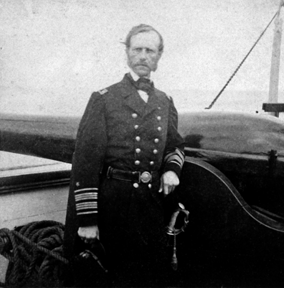Born in Philadelphia on November 13, 1809, John Adolphus Bernard Dahlgren was the son of the Swedish consul in that city. Starting his service in the U.S. Navy in 1826, John Dahlgren began his career as a common sailor; then in 1826, he joined the navy as a midshipman.
Thanks to his skill as a mathematician, Dahlgren was sent to work for the Coastal Survey from 1834 to 1837. In 1836, Dahlgren was almost blinded as a result of observing a solar eclipse. He was assigned to the Washington Navy Yard in 1847. While there, Dahlgren established the U.S. Navy's Ordnance Department; became an ordnance expert; developed a percussion lock; and wrote a number of books, including The System of Boat Armaments in the United States Navy, Shells and Shell Guns, and Naval Percussion Locks and Primers.
Under his direction, the navy established its own foundry to manufacture new equipment, and Dahlgren invented the Dahlgren gun, a more potent class of smoothbore |

|
|
John A. Dahlgren,
about 1862
(Lincoln & the War Years by Carl Sandburg, 1926) |
cannon manufactured by using iron-casting techniques to produce massive guns. Made in a variety of sizes, the Dahlgren gun became the standard weapon on Union naval vessels after 1856.
In 1861, Dahlgren's commander at the Navy Yard resigned to join the Confederate navy, and President Abraham Lincoln wanted to name Lieutenant Dahlgren to the post of Commander of the Washington Navy Yard. By law, however, that position could only be held by an officer with a rank of captain or above. |

|
Lincoln successfully persuaded Congress to pass a special act legalizing Dahlgren's appointment to the yard, and, in July 1862, Dahlgren was promoted to the rank of captain and made chief of the Bureau of Ordnance. Then in February 1863 he was promoted to Rear Admiral.
After almost 20 years on land, Dahlgren applied for sea duty, and in July 1863 he was given command of the |
Rear Admiral Dahlgren beside one of his smooth bore cast-iron guns aboard the U.S.S. Pawnee in Charleston Harbor
National Portrait Gallery,
Smithsonian Institution |
South Atlantic Blockading Squadron. While overseeing operations against Charleston, South Carolina, Dahlgren was able to see his guns in action against Fort Wagner and Fort Sumter. He was instrumental in securing Charleston's harbor, and he aided General William Tecumseh Sherman's capture of Savannah in 1864.
Also in 1864 Dahlgren's son Ulric Dahlgren, was killed while serving the Union in a controversial raid on Richmond. After the Civil war, Dahlgren remained in the navy, serving in the Pacific before going back to the Bureau of Ordnance. He returned to the Washington Navy Yard in 1869 and, once again, served as its commander until his death on July 12, 1870.
Sources:
The Civil War Society. Encyclopedia of the Civil War. New York: Portland House, 1997.
Library of Congress Civil War Section
National Portrait Gallery, Smithsonian Institution
Schneller, Robert. "A Quest for Glory: A Biography of Rear Admiral John A. Dahlgren." In Technology and Culture, July 1997.
Washington Navy Yard Historic District Office Web Site |
![]()
![]()
